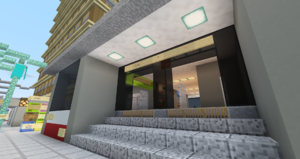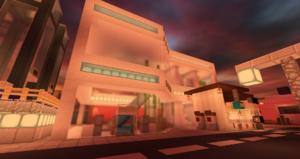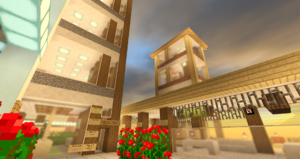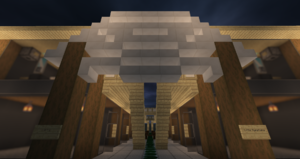Shenghua
| Shenghua 盛华 盛華 もりか | |
|---|---|
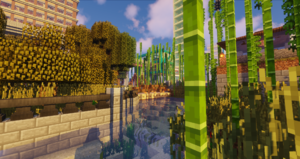 The famous Bamboo River as it winds through the city. | |
 Flag of Shenghua | |
| Officials | |
| Mayor | mi_aquamarine |
| Deputy Mayor | i____7d |
| Town recognition | |
| Rank | Senator |
| Date founded | February 29, 2020 |
| Date recognized as Mayor | September 9, 2020 |
| Date recognized as Senator | December 9, 2022 |
| Geography | |
| Town hall coordinates | -26335, 64, 14603 |
| World | New World |
| Ward(s) | Ward 6 |
| Post code(s) | SN6 |
| Transit | |
| Air facilities | Shenghua Seaplane Terminal |
| Local transit | Shenghua Transit FLR Shenghua Shenghua Bus (coming soon) |
| Etymology | |
| Language(s) | Chinese (Mandarin, Simplified characters) (Official) English (Official) Japanese (Recognized) Spanish (Recognized) |
| Political affiliations | |
| MPO(s) | Epsilonian Republic Federated States of the New World |
| Political parties | ROE:Progressive Party FS:Liberal Democratic Party |
| Lore | |
| Population | 73,895 (RP, as of 2/11/2023 6am UTC) 2 (Actual) |
The Republic of Shenghua (盛华共和国), or simply Shenghua (盛华) is an island city-state in the Zeta expansion. It is located in the Epsilonian Republic and formerly in the region of Nansei-Gunto until its dissolution on March 24, 2022. As of October 28, 2020, it and neighboring Kazeshima were the highest ranked cities in the region, both holding the rank of [Mayor]. It was also second most populous city in South Chūo province, behind Kazeshima. The city is known for its warm climate and rich culture, making it a popular destination for foreigners and Nansei-Gunto residents alike.
History
Lore
Pre-1800s
The earliest roots of Shenghuanian civilization can be traced back to the year 230 A.D., with the two settlements of Shengnan (盛南), in the present-day location of the Shenghua Ferry Terminal, and Huabei (华北), present-day Central District. In addition to the Chinese-speaking populace, Shengnan was mainly made up of Japanese-speaking Kazeshimans, while Huabei was mainly made up of Wenyangans, who mainly spoke Afrikaans, with some speaking Zulu. The two settlements started trading goods and resources, and to make it easier to cross the desert between them, the Shenghua Path (盛华大马路) (present-day North South Boulevard) was built between Shengnan and Huabei. The famous Peace Gate (和平门) was constructed at the border, and has stood ever since. The settlements grew together, both by trade between the two cities, and from trade with neighboring kingdoms, such as Kazeshima and Wenyanga. Eventually, the two settlements merged into Shenghua (盛华), a name which is retained to this day.
1800s
In the year 1835, a mysterious area of the world known as Zeta was discovered. People from the cities of Kevtropolis and Osaka rushed to colonize this mysterious land for business opportunities. The island, with its sandy beaches and warm climate, became a popular living area for workers in Kazeshima. Thus, a ferry was set up between the two cities for easy transportation between them. Several years later, in 1843, several Bahians arrived on the shore, sent by their government to understand their culture and start trade. The locals and the Bahians were friendly with each other. Many Bahians liked the tropical atmosphere, and decided to permanently migrate to the city. Thus, Spanish became a commonly spoken language in Shenghua. In 1893, Shenghua, along with neighboring cities such as Wenyanga, Shahai, New Singapore, and St. Helena were invaded by Kazeshima and placed under a brutal dictatorship. This was one of the darkest times in Shenghua's history, where many citizens were forced to give up their culture. Japanese replaced Chinese and Spanish in the education system. Chinese and Spanish text were erased from public signs, replaced by Japanese text. Many names were changed, with many babies born and renamed to Japanese names, and all streets rewritten in Japanese, notably the Shenghua Path renamed to Kazemori-ōdōri (風盛大通り). After liberation, it was renamed to its present day name, North South Boulevard (北南大道) to erase painful memories of the occupation.
1900s
The city-state of Itokani noticed these atrocities, and eventually liberated the empire in 1945, after a bloody war that lasted for five years. Shenghua thrived independently as the Autonomous Republic of Shenghua for ten years, and joined the Republic of Epsilon during that time. In 1955, the cities that were formerly part of the Kazeshiman Empire decided to form the Region of Nansei-Gunto. English was established as a common official language throughout the region to facilitate easy trade and cultural exchange. Like the rest of Nansei-Gunto, post war Shenghua was battered and destroyed by frequent airstrikes by Kazeshiman and Itokanian forces in the years before. Famines and disease were rampant, with as much as eight families crammed in one apartment. Food was hard to find, as Shenghua was located on a barren desert, with most barely surviving on cacti and dead bushes. The education system was next to non-existent, with only one public school in the city which suffered from lack of resources, and the elite sending their children to prestigious schools, such as the Flarian Academy in Gemstride. Shenghua remained in this sorry state for nearly six decades, until reforms in the turn of the century restored its glory.
2000s
In 2001, the Republic of Kevtropolis government, whose peoples settled in Shenghua long ago, poured billions of dollars into the city to improve it. Around this time, a mysterious individual named mi_aquamarine came to power, and the city experienced many reforms. Several departments were quickly set up, such as the Housing and Development Board, and soon after many families had their own home. Many schools were built, along with a mandatory education system, boosted literacy rates from 47% in 1949 to 100% in 2005. Shenghua experienced a massive boom in development in the 21st century, with several malls and skyscrapers opening. The Youli Park was also constructed in the center of the city as a place for citizens to unwind and relax. In 2012, the city started planning a metro system to serve the city in cooperation with FLR Corporation. The first line, Line S1, opened with limited service between City Hall and Shenghua South in 2020. Meanwhile in 2020, the People's Republic of Totem Beach fell under the rule of a mysterious individual named Crimson Fox, who immediately set up an authfuritarian regime in the city. The cities of Haversham, Keriyowna, and Shenghua became popular destinations for refugees. Thus, the city government constructed a rehabilitation center specifically for Totem Beach refugees, many of them brainwashed by Totem Beach's authfuritarian regime. In addition, the city government established special policies for refugees, such as free housing and free public transportation. Thus, it is widely known as one of the most refugee-friendly cities on the MRT. In 2021, Shenghua joined the Federated States of the New World and became a major production hub for propaganda educational material produced by the Liberal Democratic Party. In May of that year, protests were held in the city against Wenyanga's racist regime, which oppressed the Frockwa language and the Ruffist religion. In addition to local residents, people from neighboring cities and outside the region attended the demonstrations. Similar protests were held elsewhere in Nansei-Gunto, like New Singapore, and internationally, in cities such as Titsensaki, Northern Peninusla and Miu Wan, Republic of Miu Wan.
Geography
Rivers
Bamboo River
The Bamboo River (竹河) is the city's main freshwater river, running through Central and East Lake districts. It is named after the bamboo growing along the side of the river. It is one of Shenghua's most recognizable features.
Districts
Shenghua has four districts and one village. Districts control local infrastructure such as local roads, as well has public services not controlled by the city government such as waste management.
Central District 中央区
Central District is located on the central island of Shenghua and it is the financial and government center of the city.
Places of interest:
- City Hall
- Frank Reynolds Heliport
- Shenghua Central Library
- Villa Playa
- Youli Park
- McDonald Mansion
- McDonald Middle School
- Shenghua Transit Headquarters
- Jim Conroy Uwo Avenue High School
- Bark Memorial
- Downtown Crossing
- Peace Gate
- May 11th Monument
- ForesInn Shenghua
- Rehabilitation Center for Totem Beach Refugees
New Lansing District 新兰辛区
New Lansing is a district where high-income residents live.
East Lake District 东湖区
East Lake district is a residential and commercial district, with many malls and apartments in the areas. The ferry terminal is also located here.
Places of interest:
- Tiexia Mansion
- East Lake Clinic
- East Lake Library
- East Lake Community Garden
- Xue Hua Underground Mall
- Neo City
- Seaside City
- Reynolds Elementary School
- Shenghua South Station
- Shenghua International Ferry Terminal
Eagle Island Village 鹰岛村
Eagle Island is a rural residential area, notable for being the location of the Yu Wei She Temple.
Places of interest:
- Yu Wei She Temple
Nanwan District
Nanwan is a bike only district which is primarily a residential and commercial area.
Places of interest:
- Little Nymphalia
- Rue Quèbec
Wuming Island Village 无名岛村
Literally meaning "unnamed island", Wuming Island is a rural residential area, located approximately one kilometer away from Shenghua mainland.
Places of interest:
- Eat and Bowl
Tourism
Lodging
ForesInn Shenghua
The first hotel in the city, ForesInn Shenghua (林原酒店盛华) was constructed by i____7d as part of the ForesInn hotel chain. It is one of two locations in Nansei-Gunto, the other being in Kazeshima. Its rooms feature spacious private bathrooms, comfortable beds with a nice view of the city, cable TV, and free internet. The hotel also has a pool on the roof. It is located next to the Downtown Crossing shopping mall, as well as the Peace Gate and May 11th Monument.
Transit access: FLR Shenghua City Hall Station (Line S1)
Stop n' Slep Shenghua Nanwan
Stop n' Slep Shenghua Nanwan (休息饭店盛华南湾) is a 13-storey high-rise hotel built by STthecat as part of the Stop n' Slep budget hotel chain owned by Multi Franchises, situated just across the Bamboo River in Shenghua's Nanwan district. At 74 blocks tall, it is the fourth tallest building in Shenghua. The building stands out with its revolutionary, neomodern design based upon a podium. The first two floors are part of this podium, which consists of the main lobby, an Wuster's Burgers, 5 water slides, the Avalon Spa and a fitness center. The remaining 11 floors are occupied by a grand total of 58 rooms and 11 shared washrooms.
Transit access: FLR May 29th Station (Line S3)
Attractions
Bark Memorial
The Bark Memorial (狐狸纪念馆) was constructed in August 2020 in memory of the Murder of Mac McDonald and Frank Reynolds in Keriyowna. It features a paw print in the ground, constructed by crimsonf0x, to symbolize furry acceptance, as it is believed that the murder was a hate crime against Frank Reynolds being a furry, along with a prismarine canopy and two lecterns about the murder constructed by mi_aquamarine. Unfortunately, the memorial has become a popular target by Totem Beach extremists, with many stealing the books from the lecterns in the memorial. Thus, the memorial gained the "Free Book Dispenser" nickname against the extremists.
Transit access: FLR Shenghua City Hall Station (Line S1)
Francesca Shrine
One of the two Francesca shrines in Nansei-Gunto, the other and original one located in New Singapore, the Francesca Shrine (弗朗西斯卡神社) is where anyone can make a sacrifice to the Waypoint goddess and airport attendant Francesca. The shrine is located beside the Villa Playa shopping street and the Shenghua Seaplane Terminal. Potion and fishing rod use is prohibited on shrine grounds.
Transit access: FLR Shenghua City Hall Station (Line S1)
May 11th Monument
The May 11th Monument (5月11日纪念碑) is a prismarine gate constructed on May 12, 2020, to honor the removal of the Ucar plugin the day before. The gate goes over North South Boulevard, the principal artery of the city, and has two beacons next to each column.
Transit Access: FLR Shenghua Shenghua South Station (Line S1)
Peace Gate
One of the first things to be constructed in the city, the Peace Gate (和平门) is a gate on North South Boulevard constructed by mi_aquamarine, shortly after founding the city. It is one of the main identifying features of Shenghua, and it is based off a traditional paifang, a Chinese gate style found in eastern Asia, and at Chinatowns all over the world.
Transit access: FLR Shenghua Shenghua East Station (Line S1)
Yu Wei She Temple
One of two major temples in Nansei-Gunto, the Yu Wei She Temple (鱼尾社寺), located on rural Eagle Island off the coast of Central District, was constructed to worship Ruffism, a major religion in Shenghua. Inside is a stand for incense, a tub of holy water, reading areas, and its centerpiece, a golden statue of Ruff Ruffman. Similar statues can be seen at the Shengmiao Temple, outside of Miu Wan, and outside the FS Parliament in Central City.
Transit Access: Eagle Island Ferry Eagle Island Dock
Shopping
Shenghua is a popular destination for shopping, with an abundance of malls and shopping streets.
Downtown Crossing
Downtown Crossing (中央城) was the first mall to be constructed in the city. It is in a convenient location for travelers, located next to the city's ForesInn, and nearby several tourist attractions.
Stores include:
- Owomart
- Cocoa & Bean
- Gifts from Michigan
- Buwubbles
- Instant Ribbits
- 芝士ZONE
Neo City
Neo City (世纪城) was the second mall to be constructed in the city. It is the first mall in the city with multiple stories, and its architecture was based off the architecture in the Estify Region.
Stores include:
- Instant Ribbits
- TeleNansei
- Ben's Vibe Café
- Owomart
- Buwubbles
- Uwudon
Villa Playa
Villa Playa (海滩城) is a pedestrian shopping street in Central District next to City Hall, and is several meters away from the City Hall FLR station. The stores are located in blocks, which are small towers with a store on each floor. Villa Playa also has the Francesca Shrine, along with the Shenghua Seaplane Terminal, which has daily flights to Kazeshima with carrier FlyLumeva Turbula.
Stores include:
- Instant Ribbits
- Grape
- Bookstore of Truth
- Buwubbles
- Owomart
- Cat Café
- BankNGF
- Tropico
Little Nymphalia
Little Nymphalia (小南非亚) is a pedestrian shopping street next to the Neo City shopping mall. It is a mixed use development with stores on the first level and apartments on the second level. It is known for a large population of Nymphic immigrants who brought their culture and architecture with them.
Stores include:
- Owosmart
- ShiokShakes
- Owotech
- Wuster's Burgers
Seaside City
Seaside City (海边成) is a mall across the street from Neo City and next to the ferry terminal. It is known for its warm color palette and mushroom-like sculptures.
Stores include:
- Owotech
- Clothing store
- San He Kitchen
- TeleNansei
- Buwubbles
Transportation
Roads
Shenghua is known for one of the most well-developed road infrastructure in Nansei-Gunto, but it is also known for its extremely motorist-unfriendly policies to promote the use of public transportation. Car owners will need to have a valid Car Ownership Permit (COP). which costs 25% of their monthly income and must be renewed every year. Drivers travelling to and from Central District will need to pay a congestion charge collected via Electronic Road Payment (ERP). All roads are closed to motor vehicle traffic from 6am-2pm on Sundays, and on the first full weekend of every month. The only exceptions to this policy are persons with disabilities carrying a special license, public transit, delivery vehicles, and emergency vehicles. Shenghua drives on the right hand side, unlike Kazeshima, Wenyanga, and New Singapore, but like Shahai.
Parking
At most, Shenghua will have 1 underground public parking lot per district, limited to a maximum of 50 spaces in compliance with local laws. All public parking lots will be managed by the local government, with citywide standard parking rates.
Public Parking Rates (Maximum Stay: 5 hours)
| Time Passed | Rate |
|---|---|
| First Hour | ¥500 (MRT$5) |
| Every Additional Hour | ¥10000 (MRT$10) per hour |
Public Holidays
- January 1: New Year's Day
- Jan-Feb various dates: Lunar New Year
- Feb 29: National Day/Zeta Day
- May 11: Ucar Removal Day
- May 29: Yes
- August 15: Furry and Homosexual Acceptance Day
- First week of October: Mid-Autumn Festival
- November 6: Refugee Day
- November 7: Freedom Day
- December 24: Christmas Eve
- December 25: Christmas
- December 31: New Year's Eve
Culture
Cuisine
Shenghua is known for its highly diverse cuisine, mainly a combination of Oriental and Western dishes. A popular and well known signature dish is Shenghuanian Rice (盛华米饭), which consists of white rice with cheese, seaweed, and a meat or seafood (usually rib, chicken, or salmon).
Languages
Shenghua has a diverse linguistic culture, with Chinese, English, Japanese, and Spanish being the most spoken. The former two are official, while the latter two are recognized. Thus, most public signs are bilingual in Chinese and English, with some signs containing Japanese and Spanish as well. Chinese is the language most spoken at home, while English is used more often in business and education. All of Shenghua's laws are written in English, which means that law students need to be fluent in it. Attendees of city council meetings have the right to use any of the four languages while speaking, and municipal public services must be provided in the four languages along with Afrikaans, French, and Korean in order to service visitors from neighboring cities. Anyone attending a city trial has the right to use any language of choice. In the case it is not one of the city's official or recognized languages, an interpreter will be provided. Japanese and Spanish are also spoken at home by a significant minority, mainly immigrants from Creeperville and Bahia. The city-financed public broadcaster SBC provides radio and television services in all four languages as well.
Public services
Education
Shenghua has a free compulsory education system from grades 1-12, with elementary school running from grades 1-4 (age 6-10), middle school running from grades 5-8 (age 10-14), and high school running from grades 9-12 (age 14-18). Students also have the option of taking kindergarten from age age 3-6, in a choice of any of the four languages. Any student legally residing in Nansei-Gunto is eligible to attend, however priority is given to Shenghuanian residents in the enrollment process. The medium of education from grades 1-6 is Chinese with English as a secondary language, and the medium of education from grades 7-12 is English with Chinese as a secondary language. In addition, students in grades 9-12 are required to take a class in either Japanese in Spanish, the city's recognized languages, along with another language (Popular languages include Korean, due to the rise in popularity in Korean music, and French and German, due to increasing trade connections to the Federated States of the New World). Students are encouraged to bike, walk, or take transit to school, with free bike parking for students at each school, Infinity cards pre-loaded with free transit passes, easy pedestrian access, and schools are not built with car facilities. Schools run from 8am to 2:30pm from Monday to Thursday, and from 8am to noon on Fridays. Homework is not allowed to be assigned over weekends, with the exception of school projects, which are not allowed to be due on Mondays. This is to provide students with additional time to study and for them to have time to pursue extracurricular programs, and to spend time with friends and family. All schoolwork is prohibited from being assigned over school breaks. If a student has to leave Nansei-Gunto for an extended period of time and is not able to attend school, schoolwork is prohibited from being assigned if they are away for over a week.
Existing schools include:
- Jardín de infancia Nanwan
- Reynolds Elementary School
- McDonald Middle School
- Jim Conroy Uwo Avenue High School
Law enforcement
Shenghua has no locally-based law enforcement. The Savage City Language Police is currently stationed at Rue Quèbec and barracks are under construction. CCTV cameras in the city are equipped with technology designed to shoot Guard-San on sight. It is not known what branch of city government is responsible for handling the cameras.
Media
Television
The public Shenghua Broadcasting Corporation is the largest television broadcaster in Shenghua, with private competitors LBC and TVB also being popular. Stations from neighboring countries in the former Nansei-Gunto can also be recieved. Television is delivered by over-the-air antenna and TeleNansei cable.
| Channel name | Callsign | Channel number | Language |
|---|---|---|---|
| SBC3 | NTRS | 3 | Spanish |
| SBC4 | NSTV | 4.1 | Chinese |
| SBC News | NSTV | 4.3 | Chinese |
| SBCKids | NSTV | 4.4 | Chinese, English |
| TNN International | NTNI | 5 | English |
| SBC8 | NTVH | 8 | Japanese |
| LBC Nansei-Gunto Television | NGLX | 9 | English |
| SBC13 | NSTP | 13 | English |
| TVB Jade | NTVB | 31 | Mandarin, Cantonese |
| TVB Pearl | NTVP | 32 | English |
Demographics
Shenghua is known for its diverse population, mainly consisting of whites and Asians.
Ethnicity
- Chinese (91%)
- Native (41%)
- from Kevtropolis (27%)
- from Shahai (20%)
- Other (3%)
- Japanese (5%)
- Native (3%)
- from Kazeshima (0.5%)
- from Osaka (0.5%)
- Other (1%)
- White (3%)
- Native (2%)
- from Bahia (0.5%)
- Other (0.5%)
- Other (1%)
Language
Due to foreign influence in much of the city's history, Shenghua has a diverse linguistic environment, with Chinese and English as the official languages, and Japanese and Spanish as recognized languages.
| Language | ||||
|---|---|---|---|---|
| Chinese | ||||
| English | ||||
| Japanese | ||||
| Spanish | ||||
| Other |
Religion
Ruffism is the dominant religion among the Shenghuanian populace, with around 56% adhering to it. The Yu Wei She Temple, the first Ruffist temple in the MRT World, was constructed on Eagle Island, off the coast of mainland Shenghua. It now draws in thousands of visitors per day to pay their respects to Ruff Ruffman. Francesaism is also propular, with 4% adhering to the religion. Shenghua has one of two Francesca shrines in Nansei-Gunto, the other located in New Singapore, while the rest of the city (40%) is either affiliated with other or none religions.
List of buildings
| Name | Address | District |
|---|---|---|
Credits
- Little Nymphalia - inspired from Nymphalia by SoaPuffball
- Neo City - inspired from Estify Region by EspiDev, Seshpenguin, and Kenoi
- Bark Memorial - Somewhat assisted, yet not endorsed in the slightest, by crimsonf0x
- Unnamed terracotta apartment building - inspired from apartments in Kazeshima by i____7d
Trivia
- The name Shenghua was originally used in one of mi_aquamarine's singleplayer worlds.
- When claiming land on Zeta's opening day, Shenghua's island was mi_aquamarine's third choice. The first choice was where Santa Abeja lies, and the second choice was where Kazeshima lies.
- Several of the city's streets (e.g. Sand Street, Eumi Drive, Kazeshima Street) were named after various places on the MRT.
- The city has 3 Instant Ribbits locations, all on the same street.
- Another location can be found on a separate street.
- The H a u s in Jimbo was constructed using a similar design from a building in Shenghua.
- supykun accidentally started a conversation about toilet habits while visiting Shenghua.
- The city is known for having a high density of malls, described as "too much" by some.
- Like neighboring Kazeshima, Shenghua is an owo and uwu friendly city.
- india.mp4 is banned in Shenghua under the city's Cybersecurity Law, as the file crashes Discord upon playing it.
- The city government does not recognize the legitimacy of the Nanseian ban of My Little Pony: Friendship is Magic.
- It does, however, recognize the region's ban on Doc McStuffins. It was banned in the city several months before being made regionwide as part of legislation against hate speech.
- A large portion of the city government's revenue comes from selling ad spaces to itself.
- Installing zippers in mouths is an actively used punishment in the city.
- Ruffphobia is legal in the city.
- Furry rights are granted in the city.
- Furry rights are not granted to law breakers, such as Crimson V. Master, who is known for committing many crimes in and out of the city.
